Forum Replies Created
-
AuthorPosts
-
 Robin LeadbeaterParticipant
Robin LeadbeaterParticipantI don’t know how it relates to the progenitor but as I understand it, naked electron degenerate white dwarfs don’t show any spectral features and there are indeed some WD like that, designated spectral type DC. The spectral features then come from a thin skin of accreted material, the heavier elements rapidly sinking into the interior to become part of the electron degenerate material so most show just H while others have He or a mix of H/He. You do also find some cool white dwarfs with Carbon in their spectrum, presumably also recently accreted.
 Robin LeadbeaterParticipant
Robin LeadbeaterParticipantAnother interesting WD. No metals or Hydrogen, just Helium
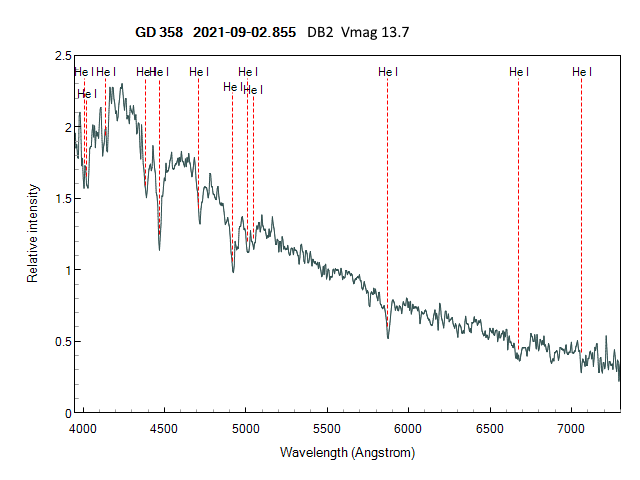
 Robin LeadbeaterParticipant
Robin LeadbeaterParticipantYes it was already clear in 2019 😉
The OI 7774 line is possibly there under the 2nd order but out of focus
 Robin LeadbeaterParticipant
Robin LeadbeaterParticipantNow at mag 16 but still within range of a very low resolution spectrum with the ALPY200.
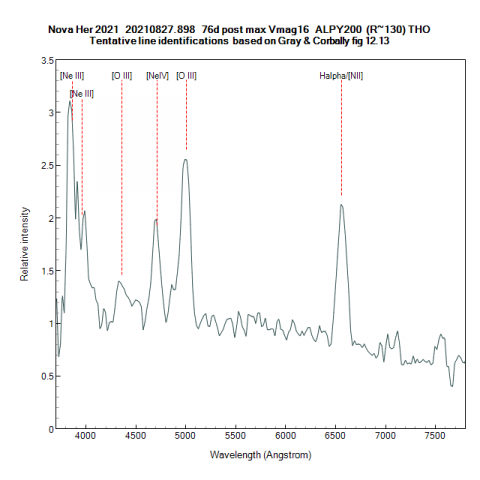
The spectrum with several forbidden nebula lines looks similar to that of another very fast nova Sgr 1991 at similar age in Gray & Corbally , where the tentative line identifications come from
Cheers
Robin
 Robin LeadbeaterParticipant
Robin LeadbeaterParticipant“ (is a 50% increase in effective radius due to pulsations feasible?)”
Though of course a smaller change in radius would be sufficient depending on the path of the hot star behind the M star
 Robin LeadbeaterParticipant
Robin LeadbeaterParticipantYes I agree. If the continuous brightness variations are due to radial pulsations of the M star, these would produce changes in the effective radius (and opacity?) of the M star. These could could asymmetrically shift the mid eclipse point dependent on their timing. (is a 50% increase in effective radius due to pulsations feasible?)
Cheers
Robin
 Robin LeadbeaterParticipant
Robin LeadbeaterParticipantHi Andy,
The measurements pre 1997 were all based on the light curves which are indeed tricky to estimate the mid eclipse point from due to the continuing brightness variability of the red giant throughout the eclipse seen in the AAVSO data in fig 5 of Hugh’s paper. The photometry and spectroscopy were in good agreement within 7 days in 1998 though.
I have extracted B-V from the AAVSO data which is less influenced by brightness variations than using using V I think. I have marked Hugh’s spectroscopic mid eclipse and the expected values based both on the earlier ephemeris and assuming a 60 day increase in period post 1978.
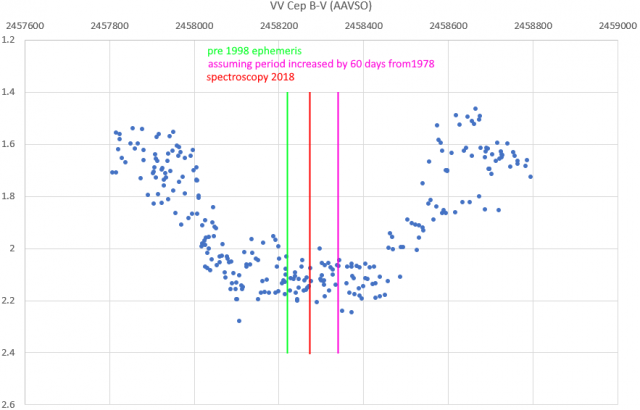
Hugh’s value agrees well with the B-V data. The prediction based on a permanent increase in period is clearly not compatible with the current data but perhaps there is enough wriggle room to say that the original ephemeris is ok and the 1997-1998 eclipse data (both spectroscopic and photometric) was anomalous for some reason?
Cheers
Robin
 Robin LeadbeaterParticipant
Robin LeadbeaterParticipantThe argument for something to have happened though between 1978 and 1998 is convincing from fig 4 of the 1999 Graczyk et al paper if the error bars are to be believed
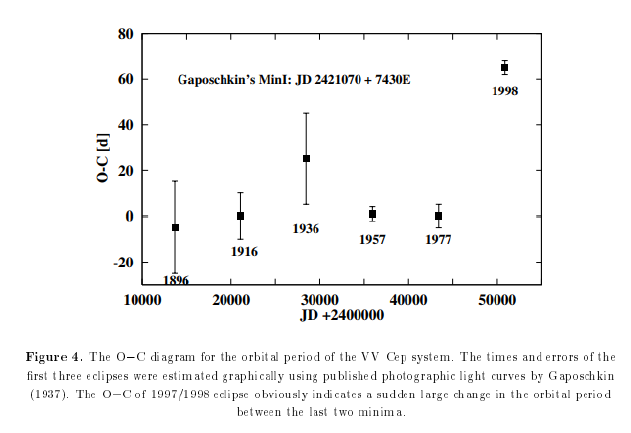
 Robin LeadbeaterParticipant
Robin LeadbeaterParticipantThere is an absolutely stunning high resolution echelle spectrum covering 3750-9300A in the BAA database from Joan Guarro Flo taken 20210809.838 using an amateur designed (by Tim Lester) home built remotely operated instrument. (zoom in to view the narrow P Cygni lines from the stellar wind superimposed on the broad nova ejecta lines) An impressive example of the progress in amateur spectroscopy since the last outburst.
Cheers
Robin
 Robin LeadbeaterParticipant
Robin LeadbeaterParticipant“The narrow unshifted feature comes from the circumsystem material from previous outbursts”
Correction that should be ….from interaction with the relatively slow moving red giant wind. This looks a good reference for the evolution of the optical spectrum in the 2006 outburst
https://academic.oup.com/mnras/article/474/3/4211/4768437
Robin
 Robin LeadbeaterParticipant
Robin LeadbeaterParticipantThis is only the start! (The narrow unshifted feature comes from the circumsystem material from previous outbursts). If it follows earlier outburst there is lots more strangeness to come. Watch for highly ionised coronal lines (like [Fe X, XI, XIV] and [A X] etc) produced as the shock heats the gas to 1 million K plus. There is an interesting account of taking spectra early in the 1958 outburst by George Wallerstein in the 2005 S&T article.
Robin
 Robin LeadbeaterParticipant
Robin LeadbeaterParticipantA series of spectra from 2006 taken using a Star Analyser.
http://www.threehillsobservatory.co.uk/astro/spectra_24.htm
I expect there will be many more spectra this time
Cheers
Robin
 Robin LeadbeaterParticipant
Robin LeadbeaterParticipantI was thinking I might offset some of the cost (~0.3%) by applying for a Ridley grant but unfortunately I see the conditions specifically exclude travel expenses.
Robin
 Robin LeadbeaterParticipant
Robin LeadbeaterParticipantSounds it is a common issue eg
https://www.cloudynights.com/topic/600195-vixen-porta-ii-slow-mo-knob-fix-for-some/
If the shaft is the same diameter, swap them out for something like these perhaps?
EDIT: from the one review on there it seems it is indeed a good solution for the porta mount
https://www.rothervalleyoptics.co.uk/skywatcher-slow-motion-cable-set.htm
(other retailers are available)
Cheers
Robin
 Robin LeadbeaterParticipant
Robin LeadbeaterParticipantAfter a brief plateau of a few days the brightness started dropping rapidly last night and the emission in the core of the Balmer absorption lines has increased.
Robin
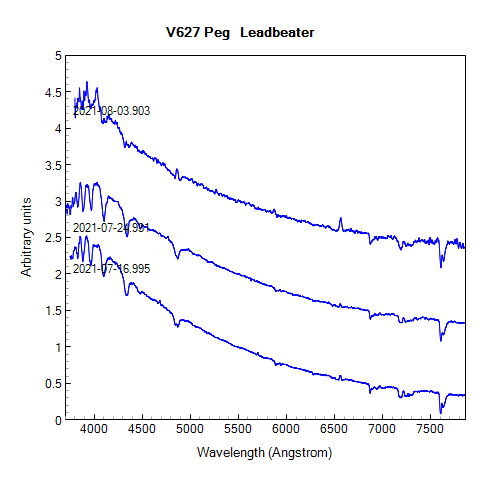
 Robin LeadbeaterParticipant
Robin LeadbeaterParticipantAgain excellent agreement with mine ~2 hrs later (using a different MILES reference star HD192640) though the the blueward absorption in the H alpha line is not resolved in the R 500 ALPY spectrum
Robin
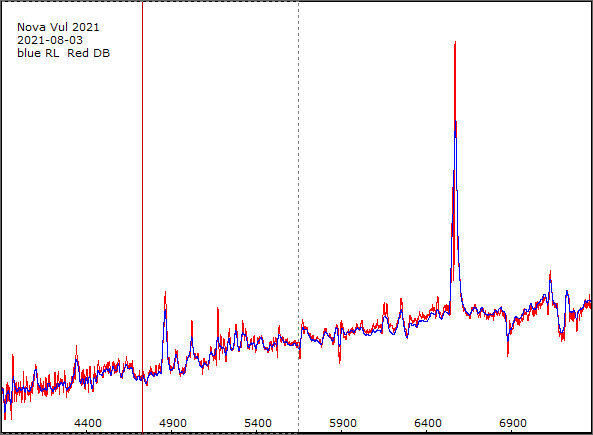
 Robin LeadbeaterParticipant
Robin LeadbeaterParticipantSignificantly fainter in the spectrograph guider tonight and the spectrum has changed completely once again with a host of strong broad emission lines appearing.
Robin
 Robin LeadbeaterParticipant
Robin LeadbeaterParticipantThe H alpha emission line has weakened further and is now showing a P Cygni profile (velocity ~600km/s). The rest of the spectrum now resembles that of a G/K star photosphere but with some additional absorption lines, particularly in the red at ~7106/7766 A (The other features in that area are Tellurics)
Cheers
Robin
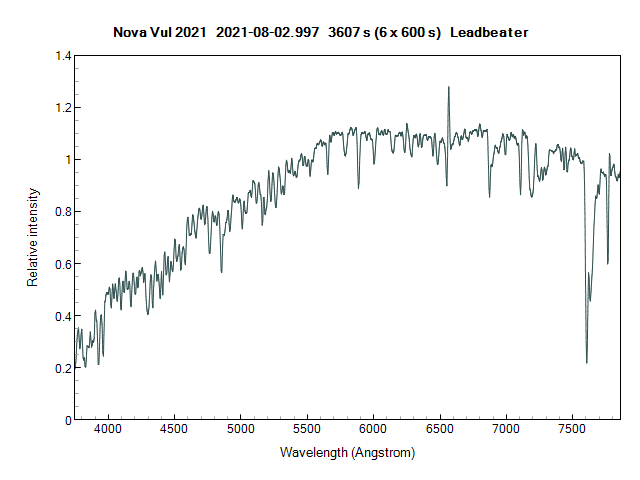
 Robin LeadbeaterParticipant
Robin LeadbeaterParticipantThe spectrum has changed significantly in the past few days. Except for a relatively weak narrow H alpha emission, all the other lines previously in emission are now either missing or in net absorption.
Cheers
Robin
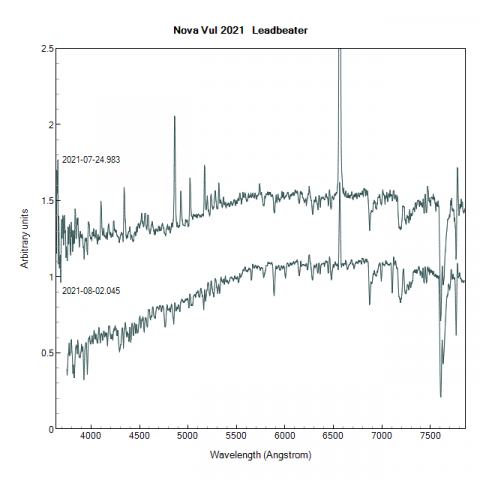
 Robin LeadbeaterParticipant
Robin LeadbeaterParticipantHi Nick,
I guess that is Nova Vul 2021 not 2001. Is that from Dan Green ? I wondered why he was asking about my instrumentation this afternoon. He must have posted it before I replied
Cheers
Robin
-
AuthorPosts
